Exploring sport online: Athletes and efficient hearts
Use 'Print preview' to check the number of pages and printer settings.
Print functionality varies between browsers.
Printable page generated Thursday, 25 April 2024, 7:45 AM
Exploring sport online: Athletes and efficient hearts
Introduction
With the announcement of the summer Olympics coming to London in 2012, fierce competition between football clubs in the domestic league, and developments in coaching and training throughout all areas of physical fitness, there has never been a better time to learn more about sport. Many of us take for granted what we know about sport, whether we participate or spectate. But have you ever thought about delving deeper, to find out more about the sport you follow in particular and how it fits into ideas about sport more generally? This course is the ideal place to start.
Sport and science have become increasingly interlinked in recent years. We need only to think of an Olympic team – which used to be mostly made up of athletes but now is likely to include a squad of almost equal size comprising non-athletic staff such as specialist coaches, trainers, sports psychologists and nutritionists – to realise how science is now a major part of sport. Elite athletes in all sports now spend a large amount of their training time with these types of specialist staff to ensure that their bodies and minds are prepared for competition in as scientific a manner as possible. Away from the elite level, there is also an increasing awareness of the benefits of a sound scientific basis to sport, training and even just basic health. Many ordinary people training in local sports centres and gymnasiums can name all their major muscle groups, know the training procedures needed to strengthen these muscles, and are aware of the effect on their bodies of the types of food and drink they consume.
In this course you will look at how sport can be understood from a scientific perspective, focussing on specific details while maintaining a broad overview of the subject using examples from many different sports such as running, athletics, cycling and swimming to illustrate the different ways in which sport and science interact.
This OpenLearn course provides a sample of level 1 study in Health & Wellbeing
Learning outcomes
After studying this course, you should be able to:
understand how the body works in a scientific sense, and that a scientific view is necessary for us to study how performance in sport is linked to performance of the body
explain the function of the heart briefly and looks at the importance of healthy hearts in sport, by looking at athletes and efficient hearts
understand the topics of blood and blood flow
understand the role of oxygen and the lungs and how they affect the sporting performance of an athlete, by looking at athletes, oxygen and the lung.
1 What to expect
In this course you will look at how sport can be understood from a scientific perspective. This is a large topic with many possible approaches. We will try to focus on specific details while maintaining a broad overview of the subject using examples from many different sports such as running, athletics, cycling and swimming to illustrate the different ways in which sport and science interact.
You will see that even a brief introduction to the science of the human body is enough to answer some basic questions about sporting activity such as:
- Why does the heart beat faster during sport?
- Why does intense activity make us red in the face?
2 A first look at the human body
2.1 Introduction
The human body is a sophisticated and amasing entity. Think about the mechanical way the limbs operate, the electrical brain functions and chemicals working together in the different body organs. All of these activities integrate in a largely seamless way to help keep us alive in ways of which most of us are barely aware! Many people are content that their own body works, and don't care much about the details. However, if we want to understand how our own body, or those of elite athletes, function during sport then we have to develop a closer understanding of our knowledge about the body.
This course provides an introduction to the fundamental biology of the human body and will give you an opportunity to:
- gain an overall appreciation of how the body works in a scientific sense, and
- understand that a scientific view is necessary for us to study how performance in sport is linked to performance of the body.
It will do this by introducing three different ways to think about the body. The first idea is to simply to think of your body as a machine. The second is to think about the different systems that operate in our bodies. The third is to think about the different parts of the body, the individual bits that we are all made up of.
2.2 The body as a machine
This is a useful way of thinking if we want to understand some basic aspects of how the body works in its relation to sport. We can think of the body as a device that operates on simple mechanical principles, that needs to be fuelled and that uses up this fuel as it is driven harder.
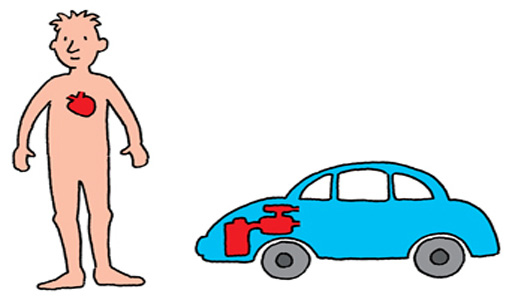
The car in the figure above has an engine at its centre and the body has a heart. In both cases there are many moving parts. For the car, the movement is performed by hydraulics, gears and levers; while for the human, the movement is created through muscles connected to bones. In both cases the ‘machine’, both mechanical and human, needs to be fuelled in order to operate properly and uses fuel as it operates. A car uses more fuel as it works harder, such as when it is driven at higher speeds. Likewise, the human body requires more fuel (food and drink) as it performs greater physical activity. Clearly we cannot go too far with this comparison but it's a very useful model if we restrict ourselves to some simple similarities.
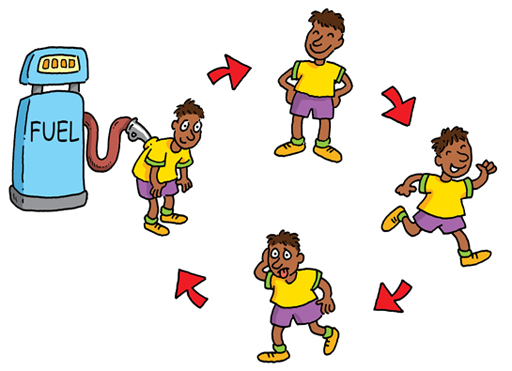
Each athlete has his or her own ‘biological machine’ and the way that they use science to improve their performance depends greatly on the sport in which they are involved. Those who sprint in any sport, for example, train their bodies in certain ways that differ from those who participate in endurance events. The engine analogy can help us understand how different elements interact within complex systems.
2.3 The body's different systems
The body has a variety of different internal systems such as the skeleton, the collection of muscles, and the network of arteries and veins. To understand properly how the body works, we need to understand these separate systems as well as the links between them.
Activity 1: What you need to do
Discussion
Did you find this interesting? Did you know about all these systems already or was there something new? This interactive diagram looks at the body by dividing it up into systems that each have specific purposes, such as breathing, moving, or thinking. Although we can look at these systems separately it is worth noting that they have to work together to make our bodies work.
Each of these systems is very interesting and there is much to learn about them. For the rest of this course we will be concentrating on the cardio-respiratory system.
2.4 The body's different components
Looking at the body this way means thinking about things as small as atoms and molecules, and as large as whole body parts. This allows us to think about how everything works at an appropriate level. If we want to understand breathing, for example, we need to think about tiny things such as the oxygen molecules that are absorbed in the body. Similarly, if we want to understand eating, we have to think of complicated internal structures such as the stomach. If we want to understand how the body moves, we have to think about body parts such as arms and legs. The figure shows the different levels that we need to think about.
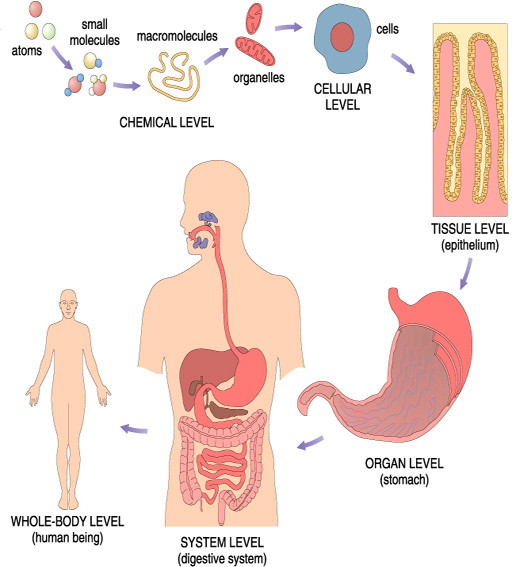
Activity 2: What I need to do
Read the discussion below to find out about the different levels of focus.
Discussion
Atoms and molecules: These are the smallest things that we need to consider. Atoms are the smallest building block of matter – the iron and calcium that our body needs are examples of single atoms. Molecules are combinations of atoms. Small molecules such as oxygen, which contains two atoms, and larger ones such as sugar molecules, which contain many more atoms, play an important role in the body.
Cells: The next stage in our tour of the body is the human cell. Cells are the smallest biological building blocks in the body, and are structures made of many atoms and molecules. The figure shows a simple cell. It has an internal part that might contain a variety of different molecules. It also has a barrier around the outside, called a membrane, that acts as a wall between the cell interior and the outside. Small particles, such as some molecules, can move in through the wall and out again, but larger ones cannot. There are many different types of cell. Each type has a limited number of functions, sometimes only one. For example, some cells in the liver take in alcohol molecules (which are a kind of poison in the body) and turn them into less harmful substances.
Body tissue: The next level up from cells is body tissue. This is biological material that is made up of combinations of many cells, put together in some particular structure. There are many types of body tissue. For example, we have fat tissue under our skins and muscle tissue in our muscles.
Body organs: We are now coming into more familiar territory, when we talk about the body organs such as the heart, the stomach and the liver. These are complicated biological structures made up of various combinations of different types of body tissue. Each body organ has a particular role in the body.
Body systems: These are combinations of organs and other body parts that have a specific role in the body. We have already seen some of these – the cardio-respiratory system (containing the heart and lungs, amongst other things) and the muscular-skeletal system. We could add many other systems to that list, such as the digestive system, which processes the food that we eat.
The whole body: This is the final stage in our explanation. The whole body is made up of many different body systems.
How did this compare as a different way of thinking about the body?
2.5 What's this got to do with sport?
So, we've seen three ways of looking at the how the body works. This is useful science but what has this to do with sport? Do athletes really need to think about their bodies scientifically, or can they just get on and compete in their own sport?
Yes, athletes (or someone in their support team) really do have to think about their bodies in these ways. One obvious example is that athletes have to know what happens when they eat before a competition.
Listen to what our fencer and runner have to say on this subject.
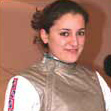
Transcript: Audio 1
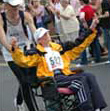
Transcript: Audio 2
Different foods have different values for the body, and elite athletes have to know the most appropriate food. Also the body takes much longer to digest some foods than others – for example, beef takes many hours to digest – so athletes have to know about this to choose what food to eat just before a competition.
Another example is that athletes have to know how their muscles work. A high jumper uses different muscles to a long jumper, and so their training regimes are likely to be very different. An athlete who follows a scientific approach that identifies the particular muscle groups which are important and ensures that they work efficiently is likely to perform better than one who follows a more traditional training schedule which doesn't place as much emphasis on a scientific approach.
2.6 Making notes
Turning ideas you learn from this course into your own words through taking notes can help sharpen your understanding and focus your thinking. The key to successful note taking is to create notes that capture the key points of what you are reading, watching or listening to, rather than writing pages and pages that are boring to write and even more boring to read! You will probably come across many new scientific terms as well as new concepts and so making notes is a good way to make sure you understand these new ideas.
The next activity gives you a chance to practice making linear notes and a mind map.
Linear notes are the most common form of note taking and probably the one with which you are most familiar. It involves writing notes by picking out and recording the most important points as you work through the course. Avoid at all costs simply typing out most or all of the text again, or just cutting and pasting large amounts of text – you won't fully engage with the material and absorb its ideas.
The best thing to do is to try to make sure your notes are in your own words as this will help you understand what you have been reading. Remember to add a reference to the part of the course your notes cover so you can easily find your way back to it.
If you haven't tried creating a mind map (or spider diagram) it is well worth giving it a try. When mind mapping you generally put the central topic in the middle of the page and then arrange the different aspects of the topic around it. Mind maps give you a clear visual representation of the relationship between points or ideas and many people find that the effort they put into constructing a mind map is enough to fix the information in their memory. One great thing about mind maps is there are really no rules – you can be as creative as you like. You can draw one by hand or you could try and create one using your word processor.
Activity 3: What you need to do
Look back over this section and make notes of the main points as you go along. Have a go at creating some linear notes and a mind map. If you are unsure about how to go about creating a mind map, read Visual techniques for revision.
Discussion
How did you get on? Did you find one type of notes easier to make? Have a look at examples of both types of notes here, how do they compare with yours?
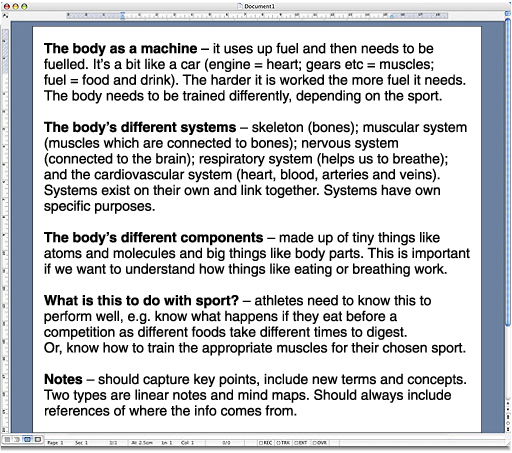
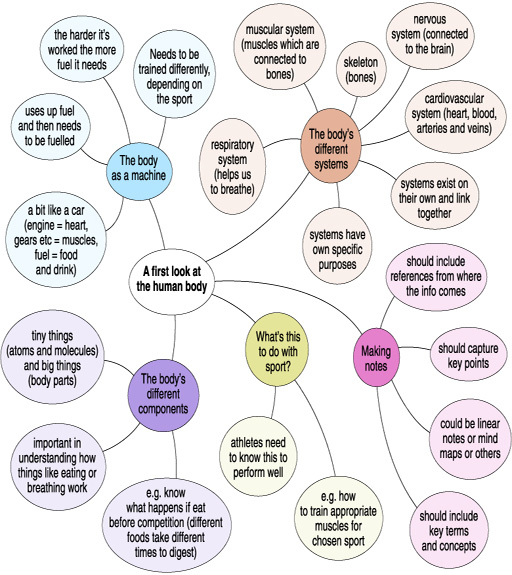
Make sure you carry on making notes as you work through the course.
2.7 A few final comments
The aim of this section was to introduce the basic elements of human biology and show you the different approaches and levels that we have to deal with when we consider the links between human biology, athletes and sport.
At this point, you should understand that in the human body:
- there are various systems of body parts that have different roles – one example is the cardiovascular system
- we have to consider things as small as atoms and molecules and as large as the systems, organs and even the whole body.
Now we have this background, we can begin to relate the way that different parts of the body function in general with the way that they function during sport.
3 The heart, blood and the lungs
We will now concentrate on the heart, the engine of the body. We will also consider the related topics of blood and blood flow, and the role of the lungs and oxygen in the body.
We all know that the heart is very important but what exactly does the heart do? Why is the blood so important? What functions do the lungs perform? In the next sections, we will try to provide at least a basic understanding so we can answer these questions and begin to understand why knowing about the heart is important for all sports people.
Don't forget to make notes as you go, as some of these activities are related to this learning skill.
4 Athletes and efficient hearts
4.1 Introduction
The heart is the engine of the human body – but what about it's specific function in athletes participating in sport? We have seen that athletes need to get oxygen and nutrients to different parts of their body quickly – this means they need an efficient cardiovascular system, this means having an efficient heart.
What do we mean by an efficient heart? We mean one that pumps a lot of blood with every beat and that can beat quickly for a long period of time. An athlete's heart differs from a non-athlete's because it is trained to become more efficient, that means to pump more blood, more quickly and to do so for longer periods of time.
Every time the heart beats it pushes blood into the arteries carrying oxygen and nutrients to different parts of our bodies. When we exercise or participate in sport, our bodies need more oxygen and more nutrients, and so we need more blood flow. This can only be achieved by pumping harder (i.e. more pump cycles per minute – we call this the heart rate) and is helped if a large amount of blood is pumped with each heartbeat.
4.2 A resting heart rate
We can understand the role of the athlete's heart in sport a little more clearly by looking at typical heart rates for trained athletes compared with heart rates for non-athletes. A commonly used measure of heart efficiency is called the resting heart rate. This is the number of times per minute that the heart beats when a person is relaxed and resting. The heart rate for a reasonably healthy adult when they are relaxed and resting is in the range of 55–65 beats per minute. This means that this person's heart has to beat about 60 times per minute to supply the amount of blood that the body needs.
When an elite athlete is relaxed and resting, their body needs the same amount of blood as the average adult mentioned above. However, because they train to make their hearts more efficient, each single beat of their heart pumps more blood than average. As a result, their hearts don't have to beat as fast to supply the same amount of blood. Hence the resting heart rate of an elite athlete is much lower than that for an average person: for many athletes, it is about 40 beats per minute. For exceptional athletes, it can be as low as 30 times per minute. This is incredibly low – if the heart rate of a ‘normal’ person was this low, they would be rushed to hospital in an ambulance! For some elite athletes, however, natural physical ability combined with training regimes can make even these extremely low heart rates perfectly healthy.
4.3 Measuring your heart rate
The most common way of measuring heart rate is by feeling the pulse at one of the arteries. The pulse is quite literally that – a pulse of blood running through the artery each time the heart does one pumping motion.
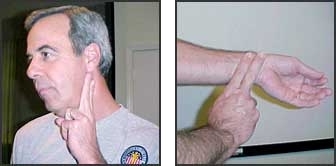
Activity 4: Measuring your pulse: what you need to do
Can you measure your own pulse? The heart rate is measured in the number of heart beats per minute. First, find a watch or clock? You can use the clock that shows on the desktop of most computers. To use it, double-click on the clock to open it so that you can see the second hand. Now put your fingers on your wrist as shown in Figure 6. If you can feel your pulse there, count how many times the artery pulses for thirty seconds, then double this number to find your own heart rate.
Discussion
Some people have trouble finding the pulse in their wrist, so don’t worry if you can’t find it easily. Another simple place to feel the pulse is at the neck, as shown in the second photograph. If you can’t find the pulse at your wrist, try at the neck. You might have to push a little to feel it strongly, but you should be able to find it.
Ask someone else to check their pulse. How does your pulse compare to theirs?
The national average for heart rate should be about 75 beats per minute. How does your pulse compare with this? Don't worry if yours is different from the national average. Your heart rate might be higher or lower than this average because you have had a busy day, are sitting up, have just eaten, have a cold, are hot or a whole range of other reasons. Try taking it again perhaps first thing in the morning before you get up. If you are concerned about your heart rate, you should seek medical advice.
4.4 Maximum heart rate
The other part of an efficient heart is the maximum rate that it can beat. If we think about competitors in a race that takes about five minutes, the athlete whose heart can beat at 200 times per minute for five minutes will probably do much better than one whose heart can only beat at 180 times per minute.
This is linked to how much blood is pumped with each beat. If an individual's heart doesn't pump very much blood when they are resting, then the heart rate has to increase so much during exercise that it cannot be sustained for a long time. A heart that pumps a lot of blood per pump already when resting doesn't have to increase the rate as much during exercise. Hence it can keep going for long periods while still pumping lots of blood. For athletes in almost any sport, an efficient heart is an advantage.
Athletes also train so that the arteries actually become larger, allowing greater blood flow around the body. Larger arteries also mean that the heart doesn't have to pump as hard to send the same volume of blood around the body.
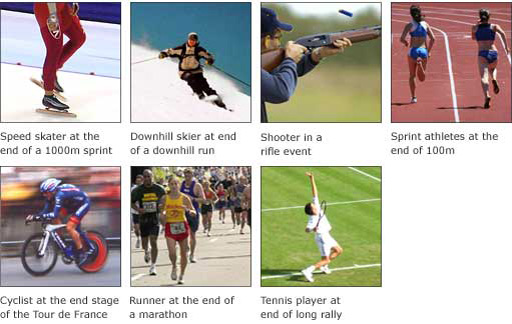
Activity 5: Athletes and heart rates: What you need to do
Think about the athletes in these photographs, and the sport involved. In which sport does the heart beat the fastest? In which one does the heart beat the slowest? Rank the athletes in these sports according to heart rate, from highest to lowest.
Discussion
| Activity | Heart rate |
|---|---|
| Speed skater | 1 – Highest |
| Downhill skier | 2 |
| Cyclist | 3 |
| Distance runner | 4 |
| Sprint athelete | 5 |
| Tennis player | 6 |
| Shooter | 7 – Lowest |
How did you do? Were any of these answers a surprise?
The order of the athletes is largely influenced by the length of the race, with the exception of the shooter as we'll see. In a very short race, like the 100 m sprint, the heart does not really get a chance to reach its maximum rate. At the end of a long exhausting race, like a long-distance cycling event or a marathon, the heart is beating as fast as it can but the body is so tired that it is not beating at its maximum rate.
So the athlete with the highest heart rate is probably the speed skater, because the distance is long enough for the heart to reach its most efficient state, but not so long that fatigue becomes important. I have said ‘probably’ because there are many variables including the differences between athletes' bodies.
Although travelling very fast, a downhill skier doesn't seem to use lots of energy. Skiers, though, have to control their bodies and this does require effort – a great deal of effort at the frenetic pace of a downhill run. This means their hearts will be driving blood to all parts of their bodies.
The distance runner and the distance cyclist probably have similar heart rates – high but fatigued. They probably put a lot of effort into the last few moments of the race, and that too affects the heart rate.
The tennis player is harder to judge. He has to use short explosive bursts of energy, and so has to act like a sprinter for fractions of seconds. However, he has to keep doing this for long periods of time, and so his heart cannot go at the rate of a 100 m sprinter, because that is not sustainable. He would not be able to start the next point if his heart was working the same as the sprinter.
The last athlete on the list, the shooter, is completely different from the others because she will have a heart-rate lower than normal. For steadiness and reliability, shooters train to slow their heart rates down in a controlled way. In fact, these athletes train so that they fire the gun in between heart beats, which gives the maximum stability.
Before you move on there have been a number of ideas we hope you have picked up in this section.
Activity 6: What you need to do
Create a list of what you think are the most important points in this section. This could be a bulleted list so doesn't have to be sentences; you should only have one idea in each bullet point.
Discussion
Compare your list to the one here. They are likely to be different as we each have our own way of recording what's important to us but some of the main points should be the same. If you've missed off some points add them to your notes before you go on.
- An efficient heart can pump a lot of blood with each pump and can beat quickly for a long time.
- Athletes train to have efficient hearts (that pump more blood with each pump, and can beat quickly for long time) to get oxygen and nutrients to all their bodies more quickly.
- Resting heart rate equals the number of beats per minute when someone is resting.
- A non-athlete's resting heart rate usually equals 55–65 beats per min.
- An athlete's resting heart usually equals 40 beats per min (can be 30!).
You can measure your heart rate by feeling your pulse at your wrist or neck.
A few final thoughts
Given what we have learnt so far the body clearly needs to be able to absorb oxygen as efficiently as possible. This means that part of being a successful athlete means having healthy lungs. This is the subject of Section 6.
5 The heart and blood
5.1 Introduction
Elite athletes are aware of the importance of heart performance and blood flow and many have specific training programmes to increase the strength and efficiency of the heart. This is not, however, just something that impacts on elite athletes. Even those of us engaged in sport at an amateur level or just for recreation will have experienced the effect of sport on the heart. After intense physical activity our heart pounds and possibly our head pounds too from the blood that is being pumped through it. Of course, if we have serious heart problems then our health suffers but even when we are more or less healthy, the strength and efficiency of our heart influences our sporting capabilities enormously.
During intense physical activity, an athlete needs to get oxygen and nutrients to all parts of his or her body. This means that the athlete needs an efficient cardiovascular system which includes:
- a healthy heart that can pump as much blood as possible
- healthy arteries and veins so that the blood can flow easily through the body and
- healthy blood that contains as much oxygen and nutrients as possible.
This section will give you a brief tour of the heart, blood vessels such as veins, arteries and capillaries and look at what blood is made up of.
5.2 Two halves of one pumping system
The heart pumps blood around the body. That might seem obvious, and you might think that there must be more to it than that, but there isn't. That is all that it does. However, this is a crucially important job.
Here is a simple diagram of a heart and you can see from it that the heart pumps two different blood circuits. These together make up one whole cycle or pulse.
One of the circuits comes from the body to the heart and goes to the lungs. This blood doesn't have much oxygen in it and is shown as blue in colour on the diagram. The other circuit comes from the lungs where it has picked up oxygen, this is shown as red on the diagram. It goes to the heart and then around the rest of the body. You can think of this circuit as refuelling the blood. A key point to remember is that blood picks up oxygen from the lungs and carries it to all the organs, muscles and the brain.
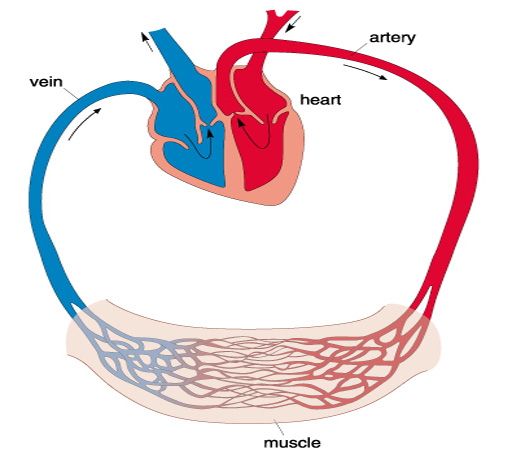
We can think of the blood going through one big cycle, through both circuits. It picks up oxygen on one half cycle, and then carries this fuel around the body, gradually distributing its supply of oxygen in the other half cycle.
5.3 Blood vessels: veins, arteries and capillaries
The tubes that carry blood around the body can be loosely divided into two types, arteries and veins. Arteries are the tubes that take blood away from the heart. They tend to be quite large, at least a few millimetres in diameter. Veins are the tubes that carry the blood back to the heart and these are usually narrower than the arteries.
The figure shows an image of the cardiovascular system, laid out from end to end. Let us imagine that this is the system that runs through one leg. An artery carries blood from the heart, it splits into smaller arteries that run through various parts of leg. After this, a number of small veins join up to one large one, which carry the blood back to the heart. An important part of the system is where the arteries divide into the thousands and even millions of smaller ‘pipes’ called capillaries. They run through all parts of the body and it is through these that the blood interacts with the rest of the body. Capillaries can be very small (thinner than a human hair) and they are different to arteries and veins because the oxygen and nutrients in the blood can move from them into the surrounding body tissue, and material in the body tissue can move from the tissue into the blood.
There are many examples of how this works: when we breathe in, the oxygen in the air is absorbed into blood capillaries running through the lungs. When we eat, the blood capillaries in our digestive system absorb nutrients into the blood, which carries them around the body to where they are needed.
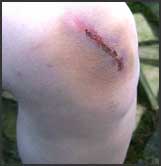
We've all seen the effect of blood vessels even if we didn't know it at the time. When we bruise part of our bodies, the reason that the area turns black is that we have damaged the blood vessels in that part of the body. Rather than flow through the blood vessel, blood escapes into the tissue, and the area turns reddish-black. Similarly, the rapid beating of our heart during physical activity sends blood flowing quickly to all parts of the body, and the areas where the blood vessels are really close to the skin turn red – which is why we may turn red in the face after exercise.
5.4 Finding your own arteries and veins

Some arteries and veins are hidden well inside the body, but we can usually find them at the joints, where they are fairly close to the surface of the skin. For example, at the back of your knee you can find the big artery that runs down your leg, carrying blood right down into the foot. Most people can find veins in their forearms where they appear as blue lines below the skin (as shown in Figure 10). In the neck, we can find both a major artery, called the carotid artery, and a major vein, the jugular vein. These take blood to and from the brain, and are relatively large: the brain needs a lot of blood.
Use the photos in Figure 10 to find the same arteries and veins in your own body. Don't be afraid to give them a bit of a push – you'll find they are quite robust.
5.5 What is blood?
So, having learned about how blood moves around the body, let's now look at what it's made up of and therefore why we need it at all, and why its health has an effect on sporting performance.
Blood has four main components – three types of cell and the watery liquid that holds these cells. Briefly, these four components are:
- Red blood cells these cells give blood its characteristic colour. They make up about seven per cent of blood and their main function is to carry oxygen molecules. The oxygen molecules attach to the red blood cells, and are carried around the body in the blood.
- White blood cells these are cells that make up about one per cent of blood. The main role of white blood cells is to fight infection. When there is a problem somewhere in the body, white blood cells in that area attack microbes such as bacteria or viruses and other impurities to try and stop the infection.
- Platelet cells these are cells whose main role is to create blood clots to help stop bleeding. When part of the blood flow system is broken (such as in a wound, both internal and external), these platelet cells move into the opening and block it, helping to stop more blood flowing out of the system.
- Blood plasma this is the watery liquid that carries the blood cells.
The blood is the body's main way of moving important material around. We've seen that oxygen is taken in through the lungs and gets to where it is needed by travelling in the blood, and this is carried along by red blood cells. The blood also carries nutrients around the body, once again by red blood cells.
The next section will combine what you've learned about the heart and blood by looking at the cardiovascular system, what we mean by an efficient cardiovascular system and how this affects athletes in a variety of sports.
5.6 A few final thoughts
You will have seen from this section that it is difficult to talk about the heart without also talking about blood and veins and arteries. It is hard to isolate one body system or one body part and describe it by itself, without talking about other parts of the body as well. One of the important points that we would like you to remember about the biology of the human body is that everything is interlinked. An athlete hoping to maximise their performance in a sport has to work on all parts of the body, not just on their heart or lungs or leg muscles.
6 Athletes, oxygen and the lungs
6.1 Introduction
We have learnt that part of the reason the heart pumps blood around is to make sure that the body gets a fresh supply of oxygen. So in the same way that our hearts need to keep beating, we need to keep breathing oxygen into our lungs to survive. But what is the function of oxygen? Why does our body need oxygen, and what does it do with it once we have breathed it in? These are some of the questions that we will examine in first part of this section.
In the second part of this section, we will look at the role of oxygen and the lungs in sport. The ability to use a large amount of oxygen efficiently is one of the most important physical attributes that an athlete can have. There are also, however, some sports for which the ability to efficiently use large amounts of oxygen is not very important at all, as we shall see.
6.2 The body, the lungs and oxygen
The figure shows a simple image of how the lungs absorb oxygen from the air.
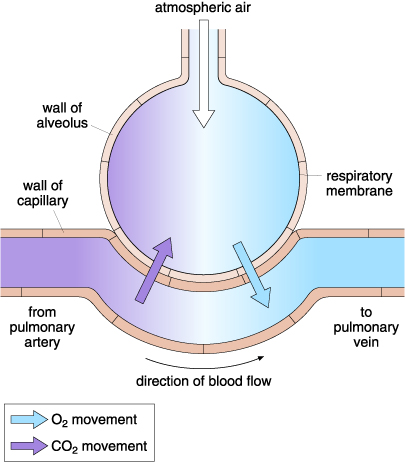
Air contains several different gases but about twenty per cent of it is oxygen. Oxygen is a relatively small molecule, and when air is drawn into the lungs, oxygen molecules pass through the tissue on the walls of the lungs and is absorbed into the bloodstream. As we've seen, red blood cells carry oxygen around the bloodstream to all parts of the body.
Blood that passes through the lungs is greatly changed by the oxygen absorption process. The blood that enters the lungs has been around the body and doesn't have much oxygen left in it, since it's been used elsewhere. After passing through the lungs, however, the blood becomes full of oxygen again. Essentially, the blood is ‘recharged’ by passing through the lungs.
6.3 The role of oxygen in sports performance
The body uses oxygen in a chemical process that produces fuel for the muscles. You might think that the transfer of oxygen from the lungs to the rest of the body is vitally important for all athletes. However, you might be surprised to hear that although this process is important in many sports, it doesn't matter very much at all in quite a few. The reason for this is fairly straightforward: the transfer of oxygen from the lungs to the rest of the body takes time. In events that don't last very long, such as sprints, and those that rely on instantaneous performance, like the high jump, there is not enough time for the oxygen taken in at the lungs to reach important parts of the body.
For many sports, however, and especially for endurance events, the capacity of the body to take in oxygen and efficiently transfer it throughout the body is very important.
6.4 Athletes and oxygen intake
In Section 4.4, we ranked a group of athletes in terms of heart rate. Now let us consider the same athletes in the same sports, but from the point of view of how efficient their respiratory system needs to be to perform in their chosen sports.
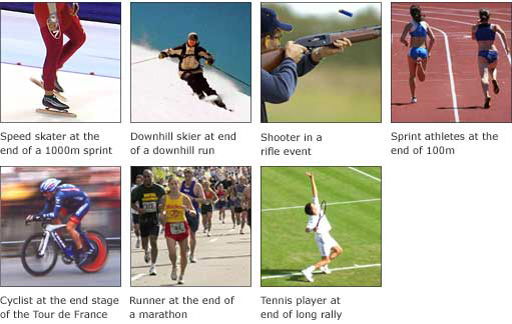
Activity 8: What you need to do
In which sports do athletes need efficient respiratory systems? Rank the sports from the one that demands the most efficiency to the least.
Discussion
| Activity | Respiratory system efficiency |
|---|---|
| Tennis player | 1 – Most efficient |
| Speed skater at the end of 1,000 m sprint | 2 |
| Downhill skier at end of a downhill run | 3 |
| Cyclist at the end of a stage of Tour de France | 4 |
| Distance runner at the end of a 10,000 m race | 5 |
| Shooter in a rifle event | 6 |
| Sprint athlete | 7 – Least efficient |
This exercise is perhaps a little more straightforward than the one about heart rates. The oxygen intake of the body is related to long-term activity, so athletes in sports that require sustained activity will benefit from having more efficient respiratory systems than athletes in shorter events. In fact, the sprinters might not even breathe very much at all during their races, as any oxygen taken during that short period will not have time get through the body to the parts which might use it: sprinters have to rely on the energy stored in their bodies, not on refuelling it as they go.
Applying the idea that long-term activity demands a more efficient respiratory system, the tennis player is a little more straightforward, because he has to perform for a long period of time, although in short bursts. Hence, he must have efficient lungs to perform well.
Again, the downhill skier is the least straightforward, for the same reason that the energy that they put into their sport is not obvious at first glance. We can see from the ranking given to them in this activity, however, that they too need to be good athletes in this sense as well.
In this case, the shooter is fairly easy to judge, because physical exertion is obviously not the most important thing in her sport.
So, how do athletes go about preparing their lungs for sport? Some endurance athletes, such as marathon runners, use the unique conditions of high altitudes.
6.5 Training at high altitude
Many of the world's best endurance athletes train at high altitudes – a long way above sea level – to improve their performance. At high altitudes there is less oxygen in the air and it's believed that the body has to work harder to extract what little oxygen remains. When the athlete returns to lower altitudes, their body retains the ability to use oxygen more efficiently and their performance will have improved.
Activity 9: What you need to do
Think about the effects there might be from training at a high altitude, low oxygen environment. Look at the possible responses below and note down the ones that you think might be true.
Training at high altitudes:
- makes the heart stronger and more efficient
- makes the lungs stronger
- increases the number of red blood and/or white blood cells
- makes the muscles stronger.
Discussion
We can use the knowledge we have gained in the previous sections to help us make a guess at what we might expect to happen.
- There is no reason to think that altitude training makes the heart stronger. As you've seen, the heart is a pump for the blood and the amount of oxygen in the blood will not affect it much.
- You might think that having less oxygen in the air means that the lungs have to work harder when breathing to get the oxygen that the body needs. This might appear to make the lungs stronger, in the same way that using your legs more makes them stronger.
- The amount of oxygen in the air does affect the blood. It increases the number of red blood cells (you'll remember these are the cells that carry oxygen around the body). This is the body's response to a lower amount of oxygen. It does not use the lungs to breathe more powerfully, but instead increases the blood's capacity to absorb the oxygen that is present. More red blood cells are made in order that the body absorbs more oxygen and gets the amount it needs. The advantage for sportspeople is felt when they return to sea-level: they have many more red-blood cells and so their body keeps this extra capacity to absorb oxygen. The extra oxygen helps them in endurance races, although the change is not permanent.
- We have not talked about muscles very much, but for now it helps to know that there is no evidence that it improves them – indeed, some researchers believe that altitude training actually reduces their effectiveness.
From the discussion, it appears that high altitude training has the potential to be beneficial. However, it is not as straightforward as it may seem. The effect of high-altitude training on blood is well known. But some coaches believe, however, that the overall effect of living at high altitude is not beneficial because the positive effect on the blood or the lungs is balanced by less beneficial bodily reactions such as a decrease in muscle strength. To get the benefits without the drawbacks, athletes can now train in altitude chambers, which are tents that have a reduced oxygen level, the kind of which you might expect at high altitudes. The athletes spend some of their time in the tent and some of the time outside. This affects their blood but allows them to train the rest of their bodies in an environment in which they are likely to compete.
Another way for an athlete to get the same advantage is for them to inject extra red blood cells into their own blood before a competition, or to use a drug that causes their own body to increase the number of red blood cells. This is illegal, and anti-doping authorities test carefully for this.
6.6 A few final thoughts
This final section has concentrated on the heart, the lungs and the blood – the body's cardio-respiratory system. We saw briefly how the body takes oxygen in through the lungs, and discussed the importance of this for athletes in various sports. To understand the role of oxygen in the body and its importance to athletes, we had to draw on information that we had discussed in earlier sections about the way oxygen is carried in the blood and the way that the heart pumps blood to different parts of the body.
This highlights an important point that you should remember. As we've seen, most things that we talk about in the body are interlinked. So, in the activity about high-altitude training, we had to use our knowledge of the lungs and the blood to understand how this would affect the body. In order to provide a more complete response, we need to think about how the oxygen is used in the body, as well as how it is absorbed. I hope it's becoming clear that we cannot really talk about the heart separately from the blood, or the blood separately from the lungs, or even the cardio-respiratory system separately from the digestive system or the muscular system.
It is worth going back and looking at your notes for this whole course.
You should have made notes for each section. Often, things that we write down as notes make sense to us when we write them but not so much sense a few weeks later. This is because when we write the notes, our heads are full of all the information in that section and so we just need one or two words to allow us to remember something. A few weeks later, though, all we have is those few words and sometimes that is not enough. So take the chance to look again at your notes. If something is a little unclear or if you can't remember what something means, go back and look at the section again and make your notes a little clearer.
Acknowledgements
Course image: David Goehring in Flickr made available under Creative Commons Attribution-NonCommercial-ShareAlike 2.0 Licence.
Grateful acknowledgement is made to the following sources for permission to reproduce material in this course:
The content acknowledged below is Proprietary and is made available under a Creative Commons Attribution-NonCommercial-ShareAlike 4.0 Licence See Terms and Conditions.
Speed Skater McSmit made available for any purpose.
Downhill skier Charles J Sharp made available under Creative Commons Attribution Sharealike 3.0.
Shooter, made available by copyright holder for any purpose.
Sprint athletes © unknown.
Cyclist (Lance-Armstrong) made available under under Creative Commons Attribution Sharealike 3.0.
Runners© unknown
Tennis player Spiralz (Flickr) Made available under Creative Commons Attribution 3.0.
(C) Getty
Don't miss out:
If reading this text has inspired you to learn more, you may be interested in joining the millions of people who discover our free learning resources and qualifications by visiting The Open University - www.open.edu/ openlearn/ free-courses
Copyright © 2016 The Open University